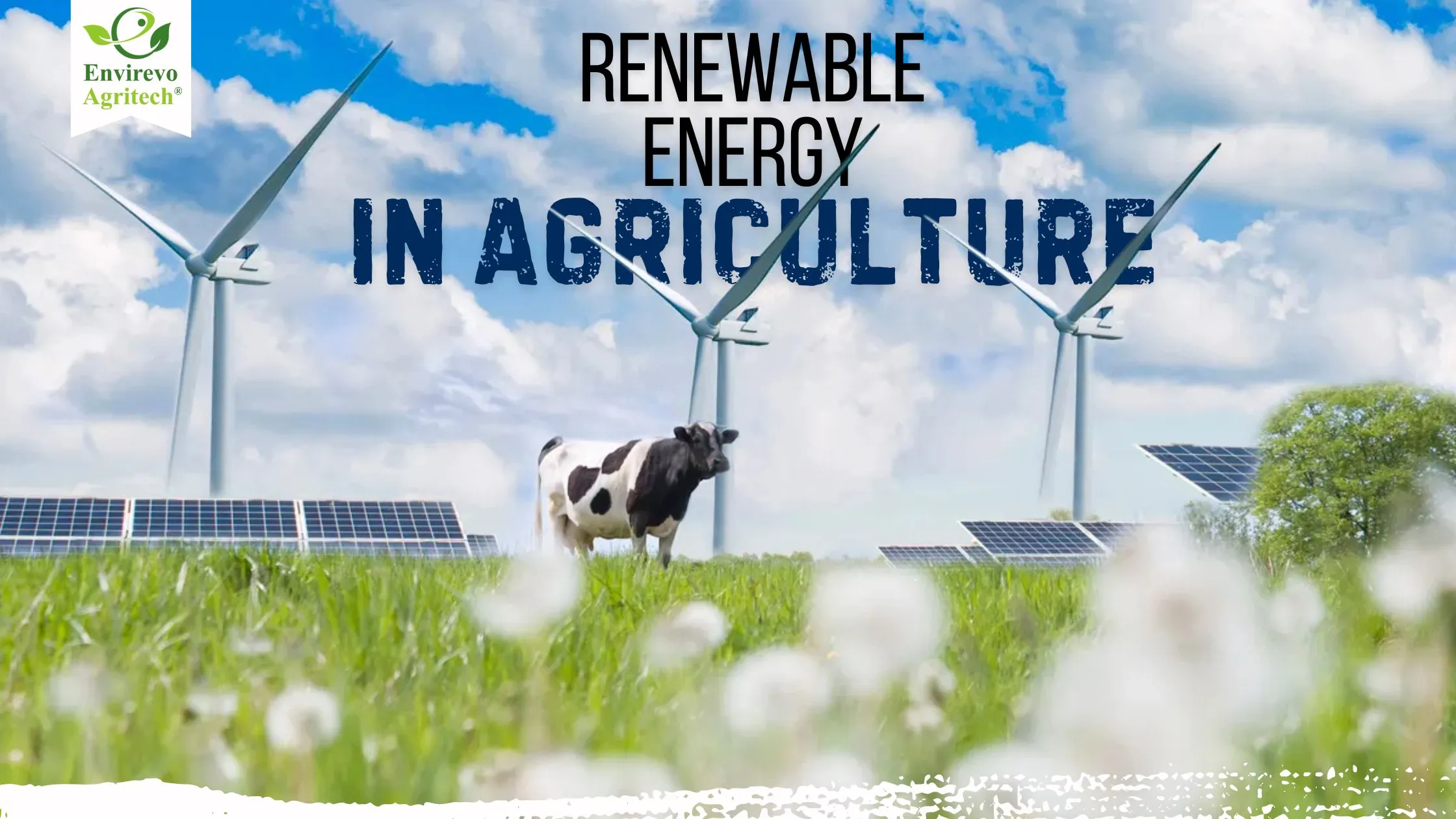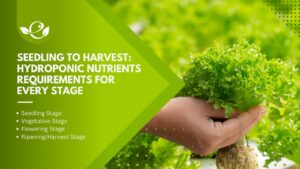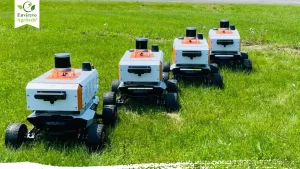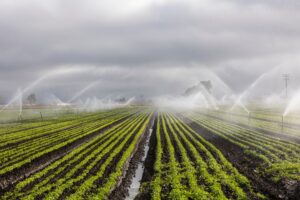Table of Contents
In recent years, farms around the globe have faced unprecedented energy cost increases—electricity bills that once averaged a few hundred dollars per month can now exceed a thousand dollars, squeezing already‐thin margins. Simultaneously, agriculture accounts for roughly one‑third of global greenhouse gas emissions, driven by fuel use in machinery, on‑farm processing, and waste management. Traditional diesel and propane burden farm budgets and contribute heavily to climate change and local air pollution.
In this context, renewable energy—including solar, wind, biogas, and geothermal—has emerged as the key to sustainable, cost‑effective, and resilient farming.
Before diving into the details, renewable energy offers farms a triple win: dramatically lower operating costs, enhanced environmental stewardship, and new revenue streams. As conventional fuel prices skyrocket and climate change accelerates, modern farms that hesitate to adopt solar, wind, biogas, and other green technologies risk falling behind both economically and ecologically. This article explores economic advantages, environmental benefits, cutting‑edge applications, policy support, and adoption challenges—all grounded in real‑world examples—so you can see exactly why making the switch isn’t optional, it’s urgent.
Economic Advantages: Cutting Costs & Creating Profits
1. Dramatic Reduction in Energy Bills
Solar photovoltaic (PV) systems installed on barns, rooftops, and open fields can offset 40–80% of on‑farm electricity usage, slashing annual energy costs by tens of thousands of dollars. Wind turbines, especially in regions with average wind speeds above 6 m/s, can generate enough electricity to power irrigation pumps, cooling systems, and processing equipment—often paying for themselves within 5–7 years. Biogas digesters convert manure and crop residues into methane, which can be burned for heat or electricity, reducing propane use in greenhouses from $1,000/month down to $100/month in documented cases.
2. New Revenue Streams Through Energy Sales
Farms with excess solar or wind capacity can participate in net‑metering or feed‑in‑tariff programs, selling surplus electricity back to local utilities at attractive rates (often 10–15¢/kWh). Leasing land to renewable energy developers—such as utility‑scale solar farms—can generate passive lease income of $500–$1,200 per acre per year, diversifying farm revenue. Anaerobic digestate (the byproduct of biogas) sells as a nutrient‑rich soil amendment, reducing fertilizer expenses by up to 50% while adding a small income stream.
Environmental Benefits: Sustainable Farming for Future Generations
1. Slashing Greenhouse Gas Emissions
By replacing diesel, propane, and grid electricity (which is often coal‑ or gas‑fired) with renewables, farms can reduce their carbon footprint by up to 70%. Biogas systems capture methane—20× more potent than CO₂—from manure lagoons, preventing its release into the atmosphere and using it as fuel instead. Agrivoltaic systems (crops beneath solar panels) not only generate electricity but also sequester carbon in healthier soils by reducing tillage and chemical fertilizer use.
2. Boosting Biodiversity and Soil Health
Trials in water‑stressed regions have shown that up to 300% more soil moisture is retained under solar arrays, benefiting shade‑tolerant crops and native pollinators. Sheep grazing beneath solar panels improves pasture biodiversity—farmers report better wool quality and higher stocking densities without overgrazing. Anaerobic digestate returns nutrients more slowly and evenly than synthetic fertilizers, improving soil structure and microbiome diversity over time.
Energy demands in agriculture
Global data show that agriculture and forestry together consumed about 3.0% of total final energy use in the EU in 2022, with oil products dominating at over 60% of that sector’s demand [European Commission].
FAO energy‐use indicators further quantify this: on average, farms expend 20–40 GJ per tonne of crop output, depending on crop type and region, reflecting the energy intensity of modern production systems.
Irrigation alone accounts for roughly 15% of all energy used in agricultural operations worldwide—some 1,896 PJ yearly—primarily to pump groundwater, which represents 89% of that irrigation energy load. As irrigated acreage expands, energy demands are projected to rise by another 28%, especially in water‑scarce regions where deeper pumping and more frequent irrigation cycles are required.
Agriculture’s energy profile is multifaceted, encompassing direct fuel and electricity use on farms, as well as energy embedded in inputs like fertilizers and pesticides. Irrigation is the single largest on‑farm energy consumer; pumping groundwater—which powers 40% of irrigated lands—accounts for 89% of irrigation’s energy demand. Mechanization (tractors, combines) and heating for greenhouses further amplify on‑farm energy needs, especially in intensive horticulture regions like the Netherlands, where agriculture and forestry represent 7.5% of the country’s total energy consumption—well above the EU average of 3.0%.
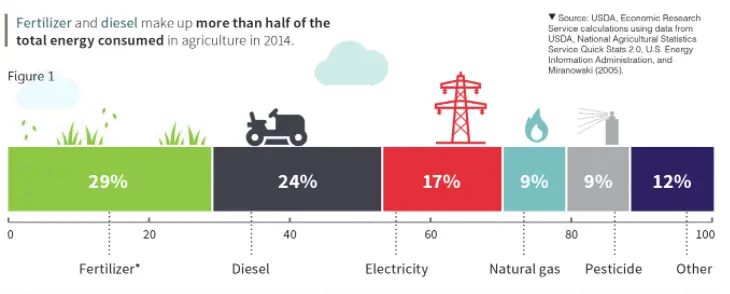
To offset high energy costs and mitigate climate impacts, future farms must embrace renewable energy and efficient nutrient recycling. Solar‑ or wind‑powered irrigation, biogas digesters for manure, and solar dryers for produce can dramatically reduce grid dependence and fossil fuel consumption. Coupled with precision nutrient management—which recycles organic wastes back to fields—these strategies can transform farms into largely self‑sufficient energy systems, lowering input costs and enhancing resilience against energy price shocks.. Implementing these measures will be critical for ensuring long‑term agricultural sustainability and food security.
Innovative Renewable Energy Applications in Agriculture
A. Agrivoltaic Farming: “Harvest the Sun Twice”
Agrivoltaics integrates PV panels with crops or livestock, allowing simultaneous food and energy production on the same land. Examples include sheep grazing under arrays in Australia—where wool yields rose into the top 5% districtwide—and strawberry cultivation beneath PV canopies in California. Globally, 477 agrivoltaic projects now represent 7.2 GW of capacity, with 150 new installations in the past nine months alone.
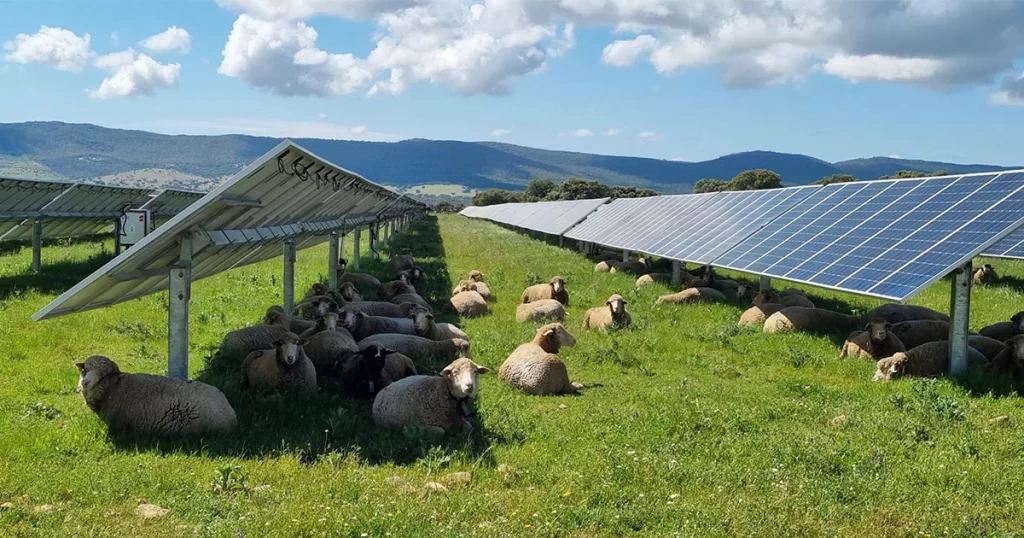
B. Geothermal Greenhouses: Year‑Round Cultivation
Closed‑loop geothermal heat pumps exchange ground and air temperatures, slashing monthly greenhouse heating costs from $1,000 to $100. Such systems stabilise daytime overheating by storing excess heat underground and re‑injecting it at night, maintaining optimal growing conditions for high‑value flowers and vegetables. Countries with volcanic activity and shallow geothermal gradients (e.g., Iceland, New Zealand) already use this model extensively; the U.S. is now following suit in small‑scale flower farms.
C. Biogas Digesters: Turning Waste into Wealth
Anaerobic digesters process livestock manure and crop residues in airtight vessels, producing biogas (60–70% methane) and nutrient‑rich digestate.
Captured biogas fuels boilers, engines, or turbines to generate electricity or heat, while digestate replaces up to half of synthetic fertiliser needs. Despite upstart costs and permitting hurdles, digester installations grew to 322 on‑farm units by 2021—driven by USDA grants and rising energy prices.
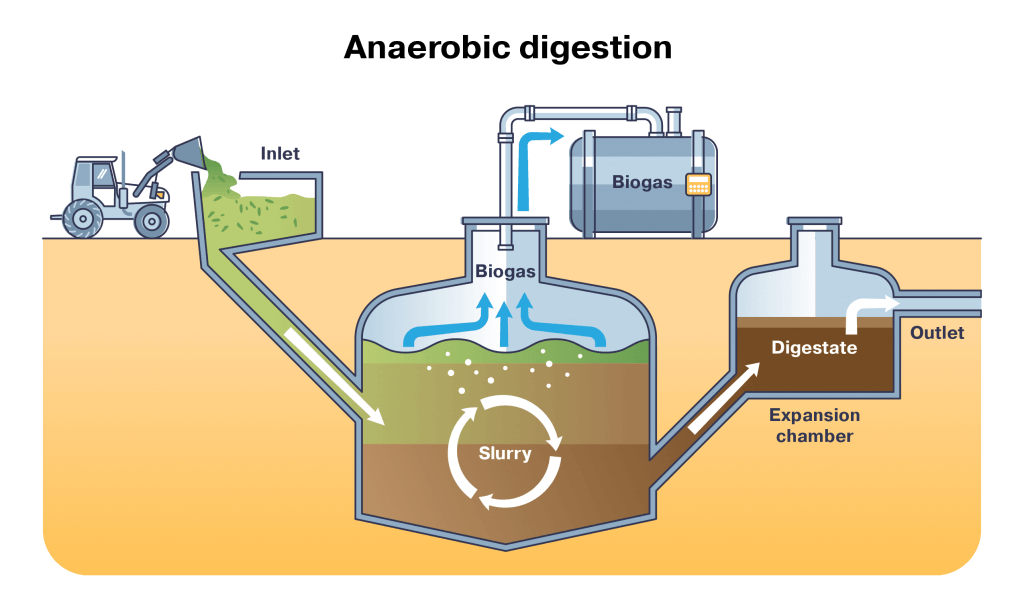
Table: Applications of renewable energy resources in different agricultural sectors.
| Agriculture Sector | Renewable Energy Resource(s) | Application | Benefits |
|---|---|---|---|
| Irrigation | Solar PV Pumps | Solar‐powered water pumping systems for crop irrigation | Ensures reliable off‐grid water supply, cuts diesel use, and reduces energy costs by over 70% in some regions. |
| Irrigation | Wind Turbines | Wind‐driven pumping to lift groundwater for irrigation | Minimizes fuel expenses, utilizes high‐wind sites effectively, and provides sustainable off‐grid irrigation. |
| Greenhouse Climate Control | Geothermal Heat Pumps | Ground‐source heating and cooling systems for year‐round greenhouse temperature management | Delivers stable temperatures, cuts heating costs by up to 80%, and lowers fossil fuel dependency. |
| Greenhouse Climate Control | Solar Thermal (Hot Water Collectors & Passive) | Solar water heating for greenhouse space heating and passive solar greenhouse designs | Extends growing seasons, reduces propane/electric heating bills by 50–70%, and enhances internal climate stability. |
| Post‑Harvest Processing | Solar Dryers | Controlled solar drying systems for fruits, vegetables, and grains | Lowers reliance on industrial dryers, improves product quality and shelf life, and cuts energy use by 60–90%. |
| Livestock Waste Management | Anaerobic Digesters | On‑farm biogas plants converting manure and residues into methane | Produces heat/electricity, reduces odor, captures methane (a potent GHG), and generates nutrient‑rich digestate. |
| Aquaculture | Solar & Wind Power | Renewable‑powered pumps, aerators, and temperature control in recirculating aquaculture systems (RAS) | Cuts electricity costs by up to 50%, lowers carbon footprint, and enhances water quality management. |
| Farm Machinery Electrification | Solar‑Charged Batteries & DC Fast Chargers | On‑site solar arrays and battery stations for charging electric tractors and equipment | Eliminates diesel consumption, reduces noise, improves worker safety, and provides energy independence. |
| Dual‑Use Land (Agrivoltaics) | Solar PV in Crop & Livestock Areas | Elevated or inter‐row solar panels combined with crop cultivation or grazing | Enhances land‐use efficiency by up to 70%, diversifies farm income, and provides shade benefits for crops and livestock. |
| Biomass Energy | Crop Residues & Dedicated Energy Crops | Combustion or gasification of agricultural residues (straw, husks) for heat and power | Valorizes waste streams, reduces fossil fuel reliance, and supports circular bioeconomy principles. |
Government Incentives & Policy Support
1. Federal Programs
The U.S. Rural Energy for America Program (REAP) covers up to 50% of renewable system costs, and—combined with low‑interest loans—can fund 75% of project expenses. The Inflation Reduction Act further expanded REAP funding and raised the Investment Tax Credit (ITC) to 30% for solar installations on farms. USDA’s Bioenergy Program for Advanced Biofuels offers grants for farmers producing cellulosic ethanol and renewable diesel feedstocks.
2. State & Local Incentives
Many states run rebate programs—like Pennsylvania’s Agriculture Energy Efficiency Rebate—that offset up to $10,000 of purchase and installation costs for solar, wind, and efficiency upgrades. The Environmental Quality Incentives Program (EQIP) On‑Farm Energy Initiative provides cost‑share assistance following an approved energy audit, covering equipment like pumps, fans, and digester components. Local utilities often offer favourable net‑metering rates or performance‑based incentives, further improving project returns.
Overcoming Adoption Challenges
1. High Initial Capital Outlay
Renewable systems require 20–30% more upfront capital than conventional equipment; however, state and federal incentives can cut net costs by up to 75%. Leasing options and third‑party power purchase agreements (PPAs) eliminate upfront hardware costs—farmers simply pay for the energy consumed at a fixed rate below retail. Cooperative models—where neighboring farms pool land and resources for a larger shared solar or wind installation—can achieve economies of scale and lower per‑acre investment.
2. Technical Expertise & Maintenance
Farmers must learn new skills or partner with specialized O&M providers to manage PV cleaning, turbine lubrication, and biogas feedstock mixing.
Universities and extension services offer training programs, and many equipment suppliers include multi‑year service contracts to ensure smooth operation. Access to reliable internet and digital monitoring platforms is essential for real‑time performance tracking and troubleshooting.
3. Regulatory & Grid Integration Hurdles
Interconnection standards vary by state and utility, with some farms facing months‑long approval delays or grid upgrade costs. Grid‑tie farms must navigate net‑metering caps and potentially unfavorable rate structures unless they form cooperatives or microgrids. Advocacy for streamlined “ag‑friendly” interconnection policies at the state level can unlock broader deployment.
Conclusion: The Time to Act Is Now
Farms that transition to renewable energy today stand to reap substantial economic, environmental, and resilience benefits—while reducing climate impact and seizing new markets. From solar arrays that boost biodiversity under their canopies, to biogas digesters that transform waste into wealth, every modern farm can harness these innovations to future‑proof operations. With federal and state incentives covering most costs—and leasing and cooperative models further lowering barriers—the true obstacle is inertia, not technology or finance.
Don’t wait until energy costs squeeze out profitability or environmental regulations tighten; invest in renewable energy now to ensure your farm remains sustainable, competitive, and ready for the challenges ahead
